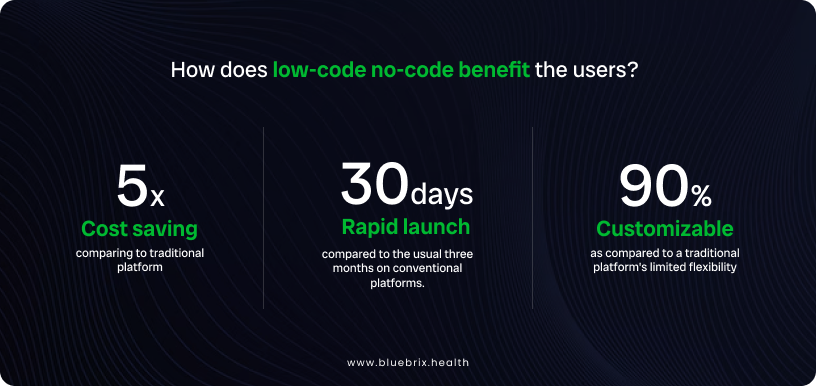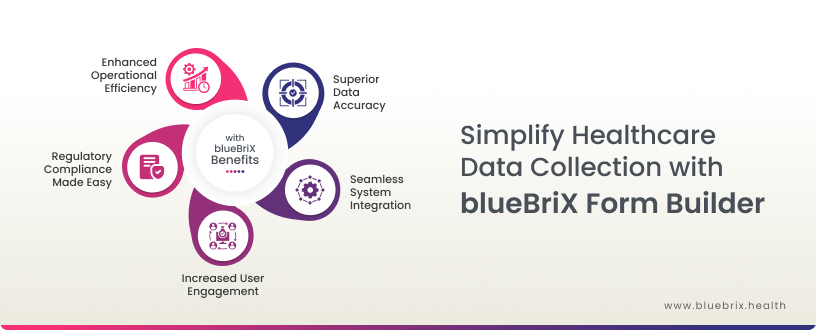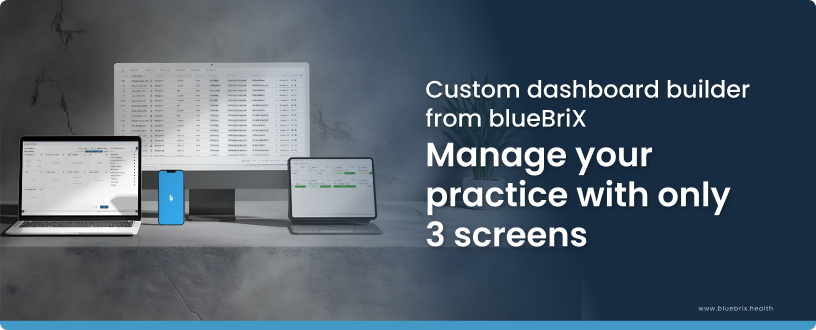The Rise of Digital Health Solutions
Did you know that the global digital health market is projected to reach USD 655.57 billion by 2029, fueled by a surge in telemedicine, mobile health applications, and AI-powered tools? By 2029, the AI healthcare technologies market is projected to reach USD 148.4 billion, signaling its increasing role in improving patient outcomes. These innovations have drastically improved healthcare efficiency, reduced operational costs, and enhanced patient outcomes, making digital health solutions indispensable in modern care delivery.
As healthcare becomes increasingly digitized, the demand for custom digital health solutions that cater to specific patient needs has skyrocketed. From streamlining administrative workflows to providing remote patient monitoring solutions, healthcare organizations are turning to technology to solve complex challenges. However, many organizations face barriers when it comes to building these tools—such as limited developer resources or the high cost of traditional development. To stay competitive, healthcare providers need a flexible, efficient way to create and deploy digital health applications that enhance care delivery, reduce inefficiencies, and improve patient satisfaction.
Healthcare needs a Robust Builder Module to Build, Manage, and Deploy Digital Health Solutions Effortlessly.
blueBriX, with its extensive experience and expertise in digital health, realized this need and designed and developed blueConsole, a cutting-edge no-code, low-code builder module designed to transform the development of digital health solutions. The blueBriX platform simplifies the process of creating tailored digital tools, such as patient engagement apps, telemedicine platforms, and workflow management systems, all while ensuring full compliance with healthcare regulations like HIPAA and GDPR. With blueConsole, users can leverage a comprehensive library of pre-built components, seamlessly integrate with existing health systems, and rapidly scale their applications to meet evolving patient and organizational needs.
By lowering the barriers to entry for health tech development, blueConsole allows healthcare organizations to address unique challenges efficiently, innovate faster, and focus on delivering high-quality care.
Why is traditional application development considered challenging?
Despite the benefits, developing digital health applications comes with its own set of challenges, especially when relying on traditional application development approaches:
Compliance and Regulatory Challenges
Healthcare applications must comply with strict regulations such as HIPAA in the U.S. or GDPR in Europe, to ensure patient data privacy and security. Traditional development often struggles with ensuring compliance across different regions and specialties.
Integration Challenges
Integration challenges are a common hurdle as businesses seek to connect disparate systems and applications to streamline operations. These challenges arise due to a variety of factors, including differences in technologies, ensuring compatibility, maintaining security, and meeting performance expectations. Successfully addressing these challenges is critical for enabling seamless workflows, improving system efficiency, and reducing operational complexity.
- Data Integration : Healthcare organizations work with multiple data sources, including Electronic Health Records (EHRs), lab results, imaging systems, and more. Integrating these into one cohesive digital application can be complex and time-consuming. Traditional approaches may require extensive customization for interoperability, leading to delayed project timelines.
- System Compatibility : Different systems may use incompatible technologies, programming languages, or architectures, making it challenging to integrate them smoothly. Legacy systems, for example, might not be compatible with modern application interfaces (APIs) or cloud-based platforms. Ensuring that old systems can communicate with newer ones requires significant customization and middleware solutions.
- API and Interface Limitations: Even though APIs facilitate integration, they can present limitations. Not all systems expose robust or well-documented APIs, and some systems may have inconsistent API updates, making it difficult to ensure stable and secure connections between applications. Poor API documentation can slow down the development process, causing integration delays.
- Security and Compliance: Integrating multiple systems often involves sharing sensitive data across platforms. Managing security protocols (e.g., encryption, authentication) and ensuring compliance with regulatory requirements such as HIPAA or GDPR across different systems can be extremely complex. Inadequate security measures can lead to vulnerabilities during integration.
- Scalability Issues: Scalability challenges in traditional application development are often due to legacy systems with outdated architectures that limit integration with modern technologies. Their monolithic design restricts flexibility and prevents efficient scaling or adoption of cloud-native features. When integrated with newer systems, legacy systems can become bottlenecks, causing performance issues. Additionally, their tightly coupled code makes modernization difficult, further hindering scalability.
- User Experience Disparities: Integrating different applications often results in inconsistent user experiences, as the user interfaces (UIs) and workflows of each system may differ significantly. Without a unified UI strategy, users may find the system cumbersome to navigate, reducing efficiency and satisfaction.
- Workflow Disruptions: Integrating new systems into existing workflows can cause operational disruptions. Employees may have to learn new tools, adapt to changes in workflows, or deal with downtime during the integration process. This challenge often requires careful planning, user training, and sometimes even changing operational protocols.
User Experience Design
The usability issues in systems with respect to providers can indeed lead to physician burnout. This stems from poorly designed interfaces that force unnecessary navigations and add complexity to workflows. When it comes to patient applications, disengagement and reduced accessibility could be the blockers. The UX for providers and patients differs significantly, as providers require complex functionalities for managing care, while patients need a streamlined interface to access their health information and interact with their care providers effortlessly.
Development Time and Costs
Traditional applications often require significant time and financial investment, as developers need to account for the complexity of healthcare workflows, data management, and regulatory requirements. Traditional development methods may not offer the flexibility to iterate and adjust the application based on real-time feedback from healthcare providers or evolving patient needs.
Do we need custom digital health applications?
In the rapidly evolving healthcare ecosystem, digital transformation transcends the mere adoption of one-size-fits-all solutions. It is about crafting custom digital health applications that deeply resonate with the unique needs of each healthcare organization and its patient community. Such personalized solutions foster adaptability, ensuring that systems integrate effortlessly into existing workflows. This bespoke approach not only enhances operational efficiency but also facilitates more meaningful, patient-centered engagement—ultimately driving improved health outcomes. The key to success lies in creating platforms that evolve alongside the organizations and individuals they serve, making healthcare more responsive, effective, and human.
Why Adaptability Matters
Custom digital health applications provide the flexibility that healthcare organizations need to adapt to their unique workflows, patient demographics, and regulatory requirements. Off-the-shelf solutions often lack the ability to cater to diverse healthcare systems, from small clinics to large hospitals, each of which has its own set of requirements.
- Personalized Care: Healthcare providers increasingly favor applications that allow for personalization of care plans, engagement tools, and clinical workflows. A custom app can be tailored to address specific patient conditions, automate follow-up protocols, and personalize the patient journey based on real-time data. This is essential for improving patient outcomes, particularly for chronic diseases and complex treatment plans.
- Scalability: Custom applications offer healthcare organizations the ability to scale up or down based on their growth or changing needs. For example, during the COVID-19 pandemic, organizations rapidly scaled their telehealth services to meet the rising demand for remote consultations. A custom solution can be modified to accommodate such sudden changes without disrupting patient care.
- Efficiency : Custom digital health applications enable healthcare providers to eliminate redundant tasks, reduce wait times, and streamline the overall care process. By automating administrative tasks such as scheduling, billing, and patient reminders, organizations can significantly boost productivity. According to a study, automation in healthcare can improve productivity by up to 50% and reduce costs by as much as 15%.
The No-Code/Low-Code Revolution in Application Building
Once dominated by highly technical professionals, the landscape of healthcare software development has now become more accessible and inclusive through no-code and low-code platforms. These platforms empower businesses to create custom applications without needing extensive coding expertise. According to Gartner, the majority of applications developed by enterprises will use no-code or low-code technologies. This democratization of app development allows professionals across various industries—whether technical or not—to rapidly bring their ideas to life, driving both innovation and efficiency.
This article serves as a comprehensive guide to understanding the fundamentals of no-code/low-code development and why it’s a game-changer for organizations. No-code/low-code platforms are revolutionizing industries by drastically reducing development timelines by up to 90% compared to traditional methods. By making development faster and more cost-effective, these platforms allow organizations to focus more on user experience and innovation, rather than getting bogged down by complex coding requirements.
Introducing blueConsole
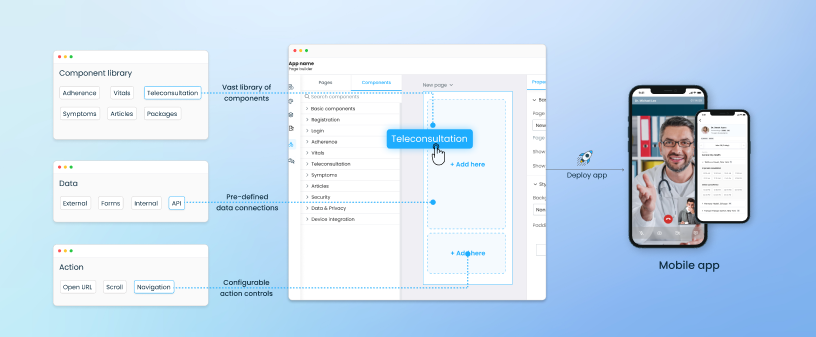
Through an in-depth exploration of blueConsole, our cutting-edge no-code/low-code builder, we will illustrate how these platforms work and the substantial benefits they provide. blueConsole stands out by not only offering intuitive development tools for non-technical users but also providing advanced customization options for seasoned developers, enabling them to accelerate project timelines without sacrificing quality or functionality. For businesses, this means drastically cutting software development costs, which, on average, can reduce costs by 50%-70% when using no-code/low-code solutions.
Whether you’re a developer looking to accelerate application delivery or a non-technical user aiming to build applications without writing code, this guide will equip you with the knowledge and insights needed to harness the full potential of blueConsole. From real-time drag-and-drop tools to integrations with existing systems, blueConsole offers a robust and user-friendly platform designed for everyone.
Moreover, we will explore how blueConsole differentiates itself from other platforms in the market, providing unique features tailored to meet the diverse needs of its users. By offering tools that streamline compliance, facilitate seamless integration with healthcare systems, and provide data security, blueConsole is engineered to meet the challenges of today’s rapidly evolving healthcare systems.
Whether you aim to transform your digital healthcare systems, enhance operational efficiency, or simply explore the possibilities of app development, this guide will serve as your roadmap to innovation.
What is a Low-Code, No-Code Builder?
Low-code and no-code platforms are development environments that allow users to create software applications without needing deep programming knowledge. No-code platforms provide a fully graphical interface where users can build apps using pre-built templates and drag-and-drop elements. Low-code platforms offer similar tools but allow some customization via minimal coding for more advanced functions. These platforms use a modular approach, enabling even non-developers to build functional applications by configuring components, instead of writing code from scratch.
How does low-code no-code benefit the users?
Low-code and no-code platforms provide a powerful alternative to traditional software development, offering numerous benefits for businesses across industries. Here are the key advantages:
1.Faster Development Cycles
Low-code/no-code platforms allow users to build applications rapidly by using pre-built templates, drag-and-drop components, and automated workflows. This significantly reduces the time it takes to go from idea to implementation. For instance, Goodgigs, a job board app, was built quickly using a no-code platform, allowing it to launch faster than it would have with traditional coding methods.
2.Reduced Costs
Developing applications with low-code/no-code platforms drastically reduces development costs. Businesses no longer need large teams of developers, as non-technical staff can handle much of the app creation. For example, companies using these platforms can cut development costs by up to 70%, especially when they need to scale apps across different departments without hiring specialized developers.
3.Empowerment of Non-Developers
Low-code/no-code tools democratize app development, enabling non-developers to build functional applications. For example, UserLoop, an app for collecting customer feedback, was built without the need for professional developers, empowering product managers to tailor the app to business needs themselves.
4.Improved Flexibility and Agility
These platforms offer agility in creating and modifying applications. Businesses can easily adapt to changes in the market or user feedback by tweaking apps without waiting for lengthy development cycles. For instance, Outsite, an app managing co-living spaces, used a no-code platform to continually improve features based on user feedback.
5.Integration with Existing Systems
Many no-code/low-code platforms provide seamless integration with existing systems like CRMs, ERPs, and other data management platforms, allowing businesses to create apps that fit into their current workflows. This reduces downtime and simplifies adoption across departments.
When and how did the concept start?
The no-code/low-code movement emerged as a solution to the increasing demand for software development in the early 2000s. The traditional development model,which relied heavily on specialized coding expertise, was proving to be too slow and costly to keep up with the fast-paced business environment. By the mid-2010s, the rise of cloud computing and the adoption of graphical interfaces made these platforms more accessible and efficient. They began gaining traction in industries like healthcare, where agility, customization, and cost-efficiency are essential.
How can healthcare benefit from low-code, no-code?
Telehealth Platforms
In healthcare, a common use case for no-code/low-code platforms is building telehealth systems. For instance, a hospital network can rapidly develop a telemedicine platform using a no-code/low-code builder like blueConsole. The platform’s drag-and-drop interface allows healthcare professionals to customize patient engagement tools, schedule video consultations, and integrate patient records from existing EHR systems. This drastically reduces the development time from several months to weeks, making it a valuable solution for addressing urgent healthcare needs.
Patient-Centric Health Monitoring
No-code platforms are often used to create remote patient monitoring applications. With sensors and IoT devices integrated into such platforms, healthcare providers can track patient vitals in real-time, such as heart rate and blood glucose levels. This not only empowers healthcare providers to intervene proactively but also helps patients manage chronic conditions effectively, without needing to frequently visit a clinic.
blueConsole: blueBriX’s Low-code No-code Application Builder
blueConsole is a powerful, no-code/low-code development platform from blueBriX designed to streamline the creation, management, and deployment of custom digital health applications. It offers a user-friendly interface tailored to healthcare professionals and developers alike, allowing users to build sophisticated applications without deep programming expertise.
The platform is built around a comprehensive dashboard that serves as the control center, where users can access key features that enable healthcare organizations to create, modify, delete, and publish applications with ease, all while offering extensive customization options via predefined templates.
What are the key benefits of blueConsole?
- Ease of Use : blueConsole is designed with an intuitive interface, enabling both technical and non-technical users to build applications through a drag-and-drop builder and customizable templates, eliminating the need for complex coding.
- Flexibility : With customizable templates and a wide range of integrations, the platform allows users to tailor apps to specific business and patient needs, making it adaptable to a variety of healthcare workflows.
- Scalability : blueConsole supports rapid scaling with its low-code/no-code infrastructure. Whether building an app for large hospital networks or a small clinic, it handles increasing user demands and data loads efficiently.
- Security: Ensuring compliance with HIPAA and other regulatory standards, the platform integrates SSO authentication and robust user management to safeguard sensitive patient information.
- Seamless Integration: One of blueConsole’s standout features is its ability to connect seamlessly with Electronic Health Record (EHR) systems, IoT devices, data warehouses, lab systems, imaging platforms, and other healthcare applications. This enables real-time data synchronization across platforms, ensuring that healthcare providers can access accurate patient data offering holistic and real-time insights into patient care.
We’ve quickly developed and deployed a customized patient management app for a medical device manufacturer using blueConsole no-code/low-code platform. For another client, we tailored our integrated EHR using blueConsole and deployed it across 30 government health centers in Africa in 2 months.
- Accelerated Time-to-Market : One of the greatest challenges in traditional digital health application development is the lengthy development cycles. With blueConsole’s no-code/low-code development environment, healthcare organizations can drastically reduce development time. Pre-built, ready to deploy templates and a drag-and-drop builder allows apps to be created in weeks rather than months, significantly accelerating deployment. For instance, a hospital could quickly roll out a patient engagement app to reduce wait times or schedule appointments efficiently.
- Enhanced Interoperability : Integration with existing healthcare systems, especially Electronic Health Records (EHRs), can be complex. blueConsole addresses this by offering seamless integration capabilities, allowing data to be synchronized in real-time. This resolves the challenge of fragmented data and disparate systems, ensuring that clinicians have access to complete patient information without switching between multiple systems. This is crucial for coordinated care in multi-disciplinary teams.
- Cost-Efficiency : Developing digital health solutions from scratch and making even small changes in an already developed application is time-consuming and incurs high costs, especially when factoring in coding expertise and testing for compliance. blueConsole reduces these costs by offering a low-code platform, where non-technical teams can develop and deploy applications. This democratization of app development allows organizations to maximize resources while ensuring quality applications.
- Improved Patient Engagement: blueConsole’s notification engine and customizable interfaces can improve patient engagement by offering real-time updates and reminders, which can help in reducing missed appointments and ensuring treatment adherence. For example, a clinic could implement automated follow-up notifications for chronic disease management, improving long-term patient outcomes.
- Multi-region Deployment: blueConsole’s built-in multi-region support ensures that healthcare providers operating across different geographical locations can seamlessly deploy their applications. This scalability allows organizations to meet diverse regulatory, operational, and patient care requirements across regions. Whether on iOS, Android, or web platforms, blueConsole enables broad accessibility, ensuring that healthcare services are efficiently managed, regardless of location.
Key Features and Capabilities of blueConsole
User-Friendly Interface
blueConsole is designed with an intuitive interface that simplifies complex processes for both developers and healthcare professionals. Its clean layout ensures easy navigation, helping users access tools and functionalities without needing extensive training. The intuitive design and ease of use, making it accessible for developers and healthcare professionals. This streamlined design enhances productivity by enabling quicker access to patient data and system management features.
Customizable Templates and Modules
blueConsole offers a variety of pre-built templates and modules that are fully customizable. These templates support a range of healthcare applications, including patient engagement, telemedicine, and remote monitoring. Whether it’s designing a patient registration form or configuring a remote monitoring system, blueConsole provides flexible tools that adapt to various therapeutic needs.
Compliance and Security
Security is paramount in healthcare, and blueConsole ensures full compliance with HIPAA, GDPR and other regulatory standards. This commitment to data security safeguards patient information, ensuring that sensitive health data remains protected at all times. With blueConsole, healthcare organizations can confidently manage patient privacy, knowing their platform meets the highest security standards.
Integration and Interoperability
blueConsole is designed to integrate seamlessly with other healthcare systems, software, and devices, enabling smooth data exchange and ensuring interoperability. This capability ensures that healthcare providers can maintain a unified flow of data across multiple platforms, improving clinical workflows and enhancing the overall quality of care.
Secure SSO and Authentication Engine
blueConsole offers a robust Single Sign-On (SSO) and authentication engine that enhances both security and user experience. Users can manage their profiles and update their SSO passwords through the intuitive “My Profile” section. This feature not only simplifies access but also strengthens data protection by integrating OAuth 2.0 standards, ensuring a seamless yet secure login process across various applications.
Drag and Drop App Builder Interface
The “Page Builder” section in blueBriX provides an easy-to-use drag-and-drop app builder, allowing users to create, modify, and publish applications effortlessly. With customizable, predefined templates, this feature is ideal for users with limited coding knowledge, making it highly effective for building healthcare apps across iOS, Android, and web platforms. The interface simplifies the inclusion of themes, CMS components, and essential app details, enabling rapid deployment across different platforms.
Notification Engine
The Notification Engine in blueConsole allows administrators to configure personalized notifications aimed at improving patient engagement and outcomes. It supports the integration of various service providers to send out timely alerts and messages, which can be managed efficiently through the notification manager. This system is instrumental in promoting proactive patient communication and improving overall healthcare service delivery.
User Management
blueConsole offers comprehensive user management capabilities, providing complete control over individual accounts and user groups. Administrators can create, manage, and organize users with enhanced policy management tools, ensuring efficient user administration, security compliance, and streamlined operations.
Marketplace
blueConsole’s Marketplace empowers users to discover and integrate a wide range of digital health tools and services. It includes blueTelemed, which provides comprehensive telemedicine solutions, enabling healthcare providers to meet patients remotely and enhance accessibility. The marketplace also offers blueIntelligence, a powerful tool for transforming and analyzing healthcare data, ensuring actionable insights that support better decision-making and improved patient outcomes.
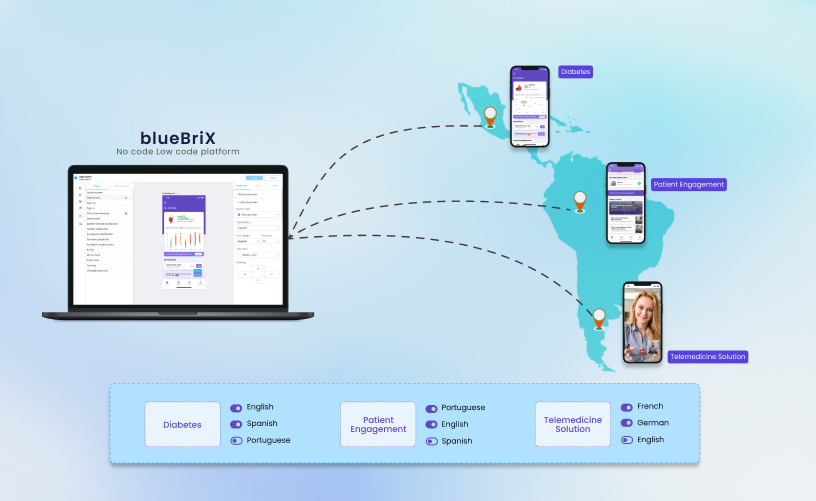
Does blueConsole simplify application management?
blueConsole makes managing applications incredibly easy by providing powerful tools for version control, user access, and data handling. The “My Applications” page acts as a hub where users can create, modify, and publish apps. Each version is locked in once created, ensuring a clear and traceable history. Users can manage versions by saving drafts, making edits, and only publishing once everything is ready.
In terms of user access, blueConsole offers a robust system that gives administrators full control. Individual users and groups can be managed effortlessly, and policies can be set to streamline administration. This enhances user management across applications, ensuring that the right people have access at the right time.
blueConsole also excels in data management. You can update data sources without having to rebuild applications. Additionally, it integrates seamlessly with services like blueTelemed and blueIntelligence, pulling data from multiple systems like EHRs and claims platforms to provide actionable insights through business intelligence tools.
Finally, the platform supports deployment across iOS, Android, and web platforms with ease. It handles mobile app builds automatically and includes tools for staging, so apps can be tested before going live. The integration process with health IT systems like EHRs is streamlined, allowing for efficient data exchange and better healthcare management.
By leveraging these features, blueConsole simplifies the deployment process across multiple platforms and ensures seamless integration with existing health IT systems, making it a powerful tool for developing and managing digital health applications.
What would be the cost impact of blueConsole?
blueConsole offers a highly cost-effective alternative to traditional development approaches, especially for healthcare applications. Its no-code and low-code features drastically reduce costs in several key areas:
- Development Time: Traditional development often requires extensive coding, testing, and iterative adjustments, leading to longer project timelines. In contrast, blueConsole’s low-code/no-code platform allows for faster development by utilizing reusable components, pre-built templates, and intuitive drag-and-drop functionality. This can reduce development time significantly compared to traditional methods.
- Staffing Costs: Traditional development typically requires a full team of highly specialized developers, engineers, and testers. With blueConsole, the need for a large, highly skilled technical team is significantly reduced. Non-technical staff or smaller teams can manage app development, cutting labor costs considerably.
- Third-party Integrations : blueConsole simplifies third-party integrations, which are often complex and expensive in traditional development. With built-in APIs and seamless integration capabilities, blueConsole minimizes the need for external development support, further reducing costs.
In effect, blueConsole provides a highly efficient, cost-saving solution for healthcare app development by minimizing development time, lowering staffing needs, and reducing reliance on external integrations.
Want to know how to build a cost-effective digital health tool uniquely catering to your healthcare organization’s requirements? Let’s connect.
Real-World Applications of blueConsole
Care Management
blueConsole enables care managers to streamline complex patient workflows by automating routine tasks like follow-up reminders and medication adherence tracking. Its drag-and-drop app builder allows custom care pathways for different patient profiles, enabling individualized care plans. The interoperability with EHR systems ensures a smooth flow of information between care managers, physicians, and other stakeholders. Additionally, the notification engine automates patient communication, keeping them engaged in their care process.
Care Coordination
For care coordination, blueConsole’s integration engine ensures seamless collaboration across multiple healthcare providers. Care coordinators can track patient transitions between primary care, specialists, and hospital care, minimizing care gaps. The platform’s secure SSO helps protect patient data as multiple stakeholders access the system, ensuring compliance with HIPAA and other regulatory requirements.
Patient Engagement
blueConsole empowers patient engagement with personalized care plans through its custom template builder, where clinicians can design individualized health education modules or interactive surveys. The system’s custom forms, dashboards and personalization features can encourage patients to actively participate in their care, boosting adherence and promoting positive behaviors. The scalable architecture ensures that these tools can be adapted as patient-needs change or expand.
Pharma
Pharma companies can use blueConsole to track clinical trials or medication adherence programs, creating custom dashboards for each drug or trial group. The platform’s ability to securely manage sensitive patient and trial data using its authentication engine ensures compliance with strict data privacy regulations. It also supports automated notifications to remind patients about their medication schedules or upcoming clinical trial appointments, improving adherence and data integrity.
Dental
In dental care, blueConsole’s custom app builder can enable dental practices to create specific solutions for patient scheduling, treatment reminders, or follow-up care. Its automation capabilities can reduce administrative burdens by streamlining patient records management, enabling seamless integration with dental imaging software or other practice management systems. This increases practice efficiency and patient satisfaction.
Therapeutix
Therapists can design specific, customizable treatment plans using blueConsole’s template builder to address individual patient needs in mental health, physical therapy, or chronic pain management. The platform supports remote patient monitoring, where clinicians can track patient progress, adjusting treatment as needed based on real-time data.
Chronic Disease Management
Chronic disease management benefits from blueConsole’s scalability and interoperability. By integrating data from various monitoring devices (e.g., blood glucose, blood pressure monitors), the platform helps clinicians track disease progress in real time. The automation of alerts for critical readings ensures that care teams can intervene before a condition worsens, while its customizable workflows facilitate regular patient follow-ups and education programs tailored to each chronic condition.
The Future of Digital Health Application Development
As healthcare technology evolves, digital health applications must stay ahead of the curve. blueConsole is built to meet the growing demands of AI integration, personalized medicine, and patient-centered care, ensuring its continued relevance and future-readiness. With healthcare systems increasingly relying on smart, data-driven solutions, blueConsole offers a powerful platform that adapts to these cutting-edge trends, positioning itself as a leader in the future of digital health application development.
What are the most interesting trends in Digital Health?
- AI Integration: Artificial Intelligence is transforming healthcare by enabling predictive diagnostics, advanced data analytics, and improved patient outcomes. AI-driven healthcare apps are becoming indispensable, providing real-time insights from patient data, optimizing treatment plans, and reducing hospital overcrowding.
- Personalized Medicine : Leveraging patient-specific data, healthcare apps can now offer targeted therapies and tailor-made treatments, moving from a one-size-fits-all approach to personalized care.
- Patient-Centered Design : Increasing focus on patient experience emphasizes intuitive, user-friendly designs that improve engagement and compliance, ensuring healthcare apps cater to the unique needs of individuals.

